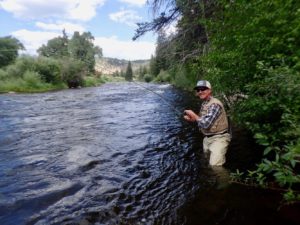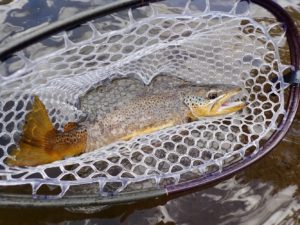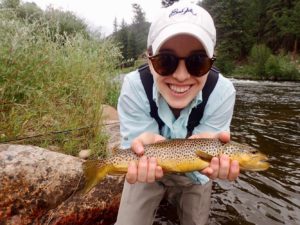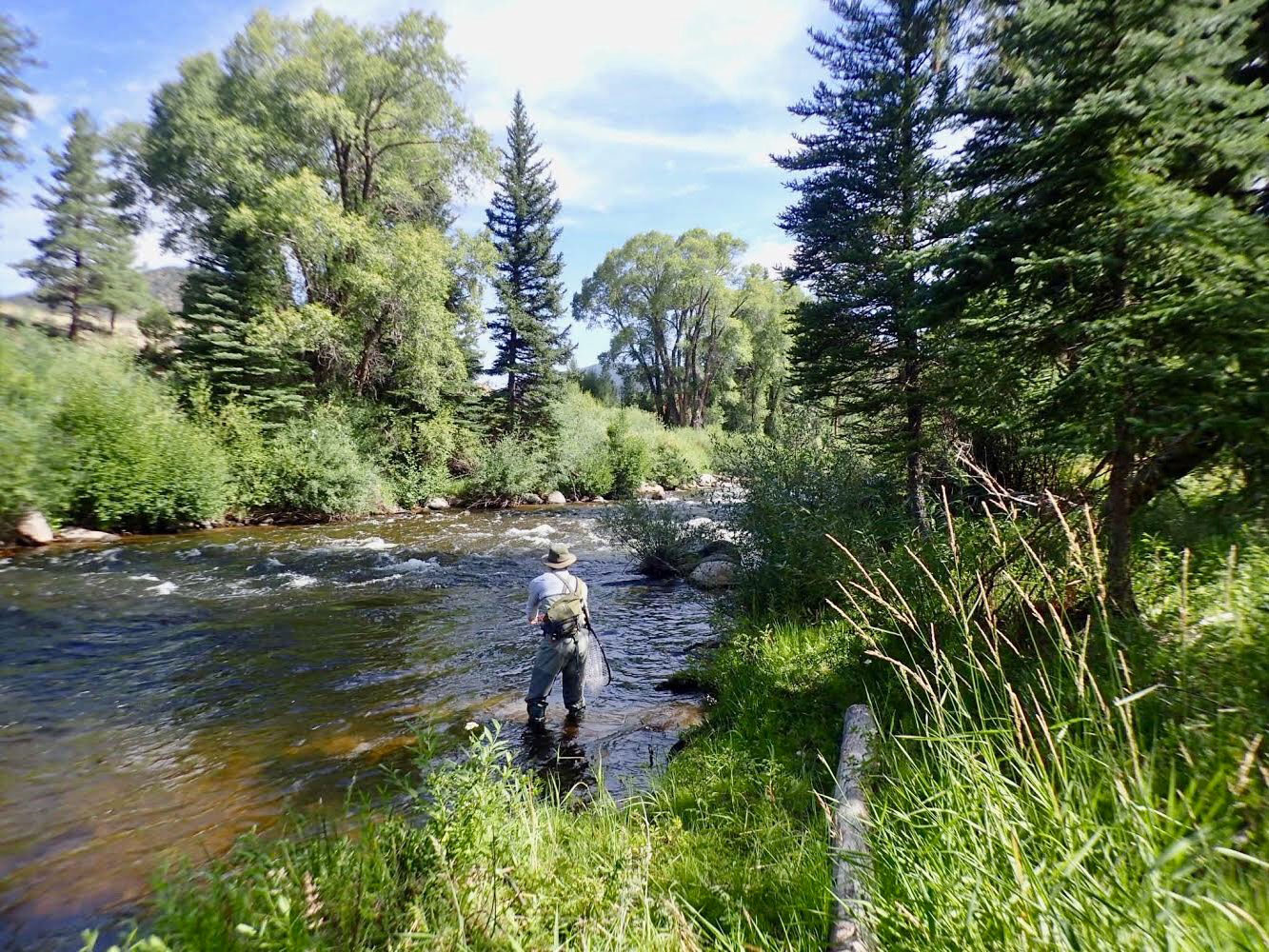As summer winds down in the mountains of Colorado, flows on the Taylor River remain strong at 115% of normal and fishing continues to be excellent. Water temps are in the very low 50’s and should hold there for a few more weeks. While the epic hatches of July and early August have passed on, fish continue to look up and dry fly fishing with smaller dries and lighter, longer leaders are very effective.

With flows in the low 400 range, the river is looking great for wading. Many spots that were hard to reach during the high water this season are approachable and it is now possible to fish spots that haven’t seen a fly all season as the river continues to drop.
Up until about 2 weeks ago, there were some epic hatches on the river. The best days were during the period when we had our brief summer monsoon as the cloudy afternoons helped trigger huge hatches of Green Drakes, Little Green Drakes, PMD’s, BWO’s, as well as a variety of Caddis and Stoneflies. There were some days when the fish were going absolutely crazy feeding on the surface and surprisingly to me, with all of the different bugs available, we had our best fishing with Caddis imitations. I may remember 2019 as the year of the Caddis at Wilder as I have never seen such long, intense and consistent Caddis hatches as I have this year.
Unfortunately, the weakening of the monsoon, dropping river levels and bright sunny weather in mid-August calmed things down a bit but this is normal for the time of year. While typically our best hatches on the Taylor are midday, during this streak of high pressure and warmth, mid-day hatches were weak and fish were feeding more during the early mornings and late evenings on Caddis. On several occasions, I watched feeding fish shut down about 10:30 am, drop to the bottom, re-emerge briefly between 1-2:30 pm and then return to their sulking until late in the evening. Nothing surprising there. Some of the best fishing can be had just before dark as huge swarms of Caddis hit the water.
Currently on the river we are seeing weaker Caddis, BWO and PMD hatches midday. Cloudy days produce the strongest hatches and there is potential for some good ones as we start rolling into fall. Mahogany duns, Slate drakes, and continued BWO hatches are in the future with the BWO’s becoming more important as we get deeper into fall. 
This can be a very good time of year to fish terrestrials to catch some big trout. Hoppers, Beetles, and Ants can all be deadly. During the next week or two when we get a rain proceeded by a couple of sunny days, the flying ants will start to form huge columns during their recolonization process. If you see the sky full of small, transparent wings it is a good bet that fish are going crazy somewhere eating Ants. Typically the Ants will be around a size 20 and black. Another sign of an Ant fall is if you see fish rising and don’t see any bugs (wings) on the water. The ants will lie flat and are almost invisible to us. Additionally, a size 18 foam beetle or ant pattern can be just the thing to fool a selective fish that has refused other flies. While I have never caught a lot of fish on a Hopper in our section of the river, I have caught some larger fish and during slow periods on the river, a Hopper pattern can trigger fish that are otherwise lethargic. It is also perfect for attaching a dropper too, although fishing the banks and tight places is more problematic with a dropper.
We are still catching fish on Caddis patterns (14-18), particularly if they are skated and or twitched below the angler. Para Adams (18-20), BWO’s (20), PMDs (16) and Madame X’s (8-16) have all been effective dries. Two-bit hookers, Pheasant tails, Caddis emergers, and BWO nymphs have been effective as droppers in sizes 14-20 with 5x or 6x.
During this time of year as the water gets lower, fish get shyer and bugs get smaller, it is time to start thinking about that spool of 6x in your vest. Long, light leaders considerably increase your odds of hooking fish during late summer fishing. I like taking a 9’ 4x leader and adding 2 feet of either 5x or 6x to that depending on the dry I choose. Not only does a longer, more supple leader allow for a better drift, it also aids in how your fly hits the water. The softer the better. Big fish will come up and eat very small dries if they hit the water softly. Hard hits with small dries will only produce small fish.

As the waters continue to drop throughout the fall, this can be a great time of year to sight fish. Concentrate looking in places that have a light-colored bottom, under foam lines and on the edges of faster currents. If you are able to spot a larger fish, then you can cast directly to him and decrease the odds of a smaller guy eating your fly first.
As usual, remember that your two best weapons as an angler are stealth and observation. Have a good look before entering the water and when you do, move slowly and cast lightly.
The fishing on the Dream Stream was phenomenal early season but as the bright sun and lowering water took their toll, fish got sluggish and very spooky. This all changed again last week when the hay meadow flood irrigation water was redirected into the stream to let the hay dry out for harvest. Three things happened here: Water temps dropped due to faster and higher flows, fish activated with a rise in water and oxygen levels and the grasshopper population is very high this year.
While smaller bugs such as BWO and Caddis are currently hatching in the stream, the real target for the fish right now is grasshoppers. Look for hot and windy afternoons to provide the best action, as strong winds will blow active hoppers into the stream and the fish know it. We have had success with just about any hopper pattern that we have tried lately. Make sure you use tippets of 3x or 4x as 5x is too light to turn the large flies over and also a way to light to survive a crushing strike from a big fish who may head directly into the weeds once hooked. Also, heavier tippets make it possible to land the fish fast and release it unharmed.
In addition to the obvious foam lines and sweet spots of the pools, you will also find fish lying against the banks in wait for an errant hopper. Make sure to fish the banks well before walking up the trail.
Over the next few days, the hay will be cut and I expect the fish to go crazy for another week or so feasting on hoppers. This is a perfect time to get out there and experience the violent slurping takes of large trout and enjoy a late summer banner day on the Dream Stream.
The 6 ponds at Wilder are all fishing well and have received very little pressure this season. Large trout lie in wait and are currently feasting on Damselflies, Hoppers, Midges and some small random Mayfly hatches. As the morning heats up and air temps reach about 60 degrees, the Damsels will start flying and you will see fish launching in the air to capture the Damsels as they are flying over the water.
As you walk along the pond edges, you will see some fish lying stationary along the shorelines waiting to ambush and unsuspecting Damsel nymph and others cruising the edges of the weed lines looking for whatever they can find. Best is to locate a target and cast your fly 6-10 feet in front of the fish.

My first option for this time of year is a Damsel dry. Make sure that you show it to a few fish before changing. If unsuccessful, my next move might be to try a small Hopper or Madame X, twitching it lightly to attract a fish and leaving it still on the water as a fish approaches. If both of these fail, then it may be time to attach a small dropper or try a black or olive Wooly Bugger fished slow and deep.
Please use 3x or 4x tippets so you can land the fish quickly and get him back in the water asap. Make sure to revive the fish a bit until he gives a strong kick and watch him as he swims away to make sure he is not disoriented and is right-side up. If you get a fish that turns upside down, recapture him in the net and give him some more time to recover. Oftentimes just a poke with your rod tip can wake them up to get them going again.
Just a reminder to please pinch all barbs on all flies used at Wilder (and anywhere else that you plan to catch and release). If you want a picture of a fish please leave him in the water to do so or use the 5-second rule and get him back into the water inside this time limit.
As always I’ll look forward to seeing you all on the water. Please feel free to contact me directly for questions, concerns or ideas.
Keep your backcasts high (but out of the trees)!









